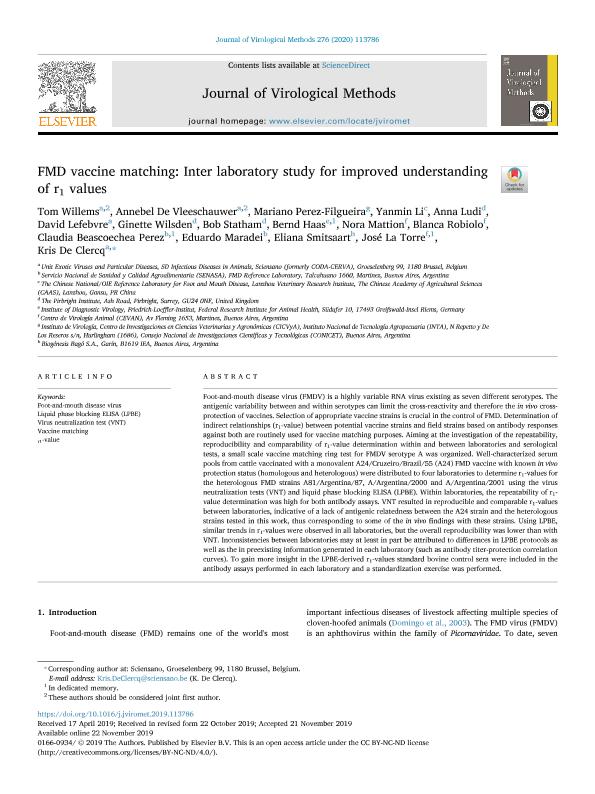Artículo
FMD vaccine matching: Inter laboratory study for improved understanding of r1 values
Willems, Tom; De Vleeschauwer, Annebel; Pérez Filgueira, Daniel Mariano ; Li, Yanmin; Ludi, Anna; Lefebvre, David; Wilsden, Ginette; Statham, Bob; Haas, Bernd; Mattion, Nora Marta
; Li, Yanmin; Ludi, Anna; Lefebvre, David; Wilsden, Ginette; Statham, Bob; Haas, Bernd; Mattion, Nora Marta ; Robiolo, Blanca; Beascoechea Perez, Claudia; Maradei, Eduardo; Smitsaart, Eliana; la Torre, Jose Leonardo
; Robiolo, Blanca; Beascoechea Perez, Claudia; Maradei, Eduardo; Smitsaart, Eliana; la Torre, Jose Leonardo ; De Clercq, Kris
; De Clercq, Kris
 ; Li, Yanmin; Ludi, Anna; Lefebvre, David; Wilsden, Ginette; Statham, Bob; Haas, Bernd; Mattion, Nora Marta
; Li, Yanmin; Ludi, Anna; Lefebvre, David; Wilsden, Ginette; Statham, Bob; Haas, Bernd; Mattion, Nora Marta ; Robiolo, Blanca; Beascoechea Perez, Claudia; Maradei, Eduardo; Smitsaart, Eliana; la Torre, Jose Leonardo
; Robiolo, Blanca; Beascoechea Perez, Claudia; Maradei, Eduardo; Smitsaart, Eliana; la Torre, Jose Leonardo ; De Clercq, Kris
; De Clercq, Kris
Fecha de publicación:
02/2020
Editorial:
Elsevier Science
Revista:
Journal of Virological Methods
ISSN:
0166-0934
e-ISSN:
1879-0984
Idioma:
Inglés
Tipo de recurso:
Artículo publicado
Clasificación temática:
Resumen
Foot-and-mouth disease virus (FMDV) is a highly variable RNA virus existing as seven different serotypes. The antigenic variability between and within serotypes can limit the cross-reactivity and therefore the in vivo cross-protection of vaccines. Selection of appropriate vaccine strains is crucial in the control of FMD. Determination of indirect relationships (r1-value) between potential vaccine strains and field strains based on antibody responses against both are routinely used for vaccine matching purposes. Aiming at the investigation of the repeatability, reproducibility and comparability of r1-value determination within and between laboratories and serological tests, a small scale vaccine matching ring test for FMDV serotype A was organized. Well-characterized serum pools from cattle vaccinated with a monovalent A24/Cruzeiro/Brazil/55 (A24) FMD vaccine with known in vivo protection status (homologous and heterologous) were distributed to four laboratories to determine r1-values for the heterologous FMD strains A81/Argentina/87, A/Argentina/2000 and A/Argentina/2001 using the virus neutralization tests (VNT) and liquid phase blocking ELISA (LPBE). Within laboratories, the repeatability of r1-value determination was high for both antibody assays. VNT resulted in reproducible and comparable r1-values between laboratories, indicative of a lack of antigenic relatedness between the A24 strain and the heterologous strains tested in this work, thus corresponding to some of the in vivo findings with these strains. Using LPBE, similar trends in r1-values were observed in all laboratories, but the overall reproducibility was lower than with VNT. Inconsistencies between laboratories may at least in part be attributed to differences in LPBE protocols as well as the in preexisting information generated in each laboratory (such as antibody titer-protection correlation curves). To gain more insight in the LPBE-derived r1-values standard bovine control sera were included in the antibody assays performed in each laboratory and a standardization exercise was performed.
Archivos asociados
Licencia
Identificadores
Colecciones
Articulos (CEVHAN)
Articulos de CENTRO DE VIROLOGIA HUMANA Y ANIMAL
Articulos de CENTRO DE VIROLOGIA HUMANA Y ANIMAL
Articulos (IVIT)
Articulos de INSTITUTO DE VIROLOGIA E INNOVACIONES TECNOLOGICAS
Articulos de INSTITUTO DE VIROLOGIA E INNOVACIONES TECNOLOGICAS
Citación
Willems, Tom; De Vleeschauwer, Annebel; Pérez Filgueira, Daniel Mariano; Li, Yanmin; Ludi, Anna; et al.; FMD vaccine matching: Inter laboratory study for improved understanding of r1 values; Elsevier Science; Journal of Virological Methods; 276; 1; 2-2020; 113786-113792
Compartir
Altmétricas



